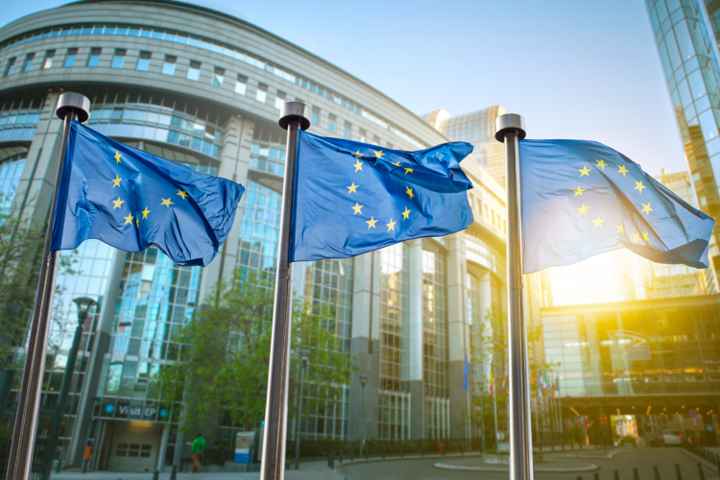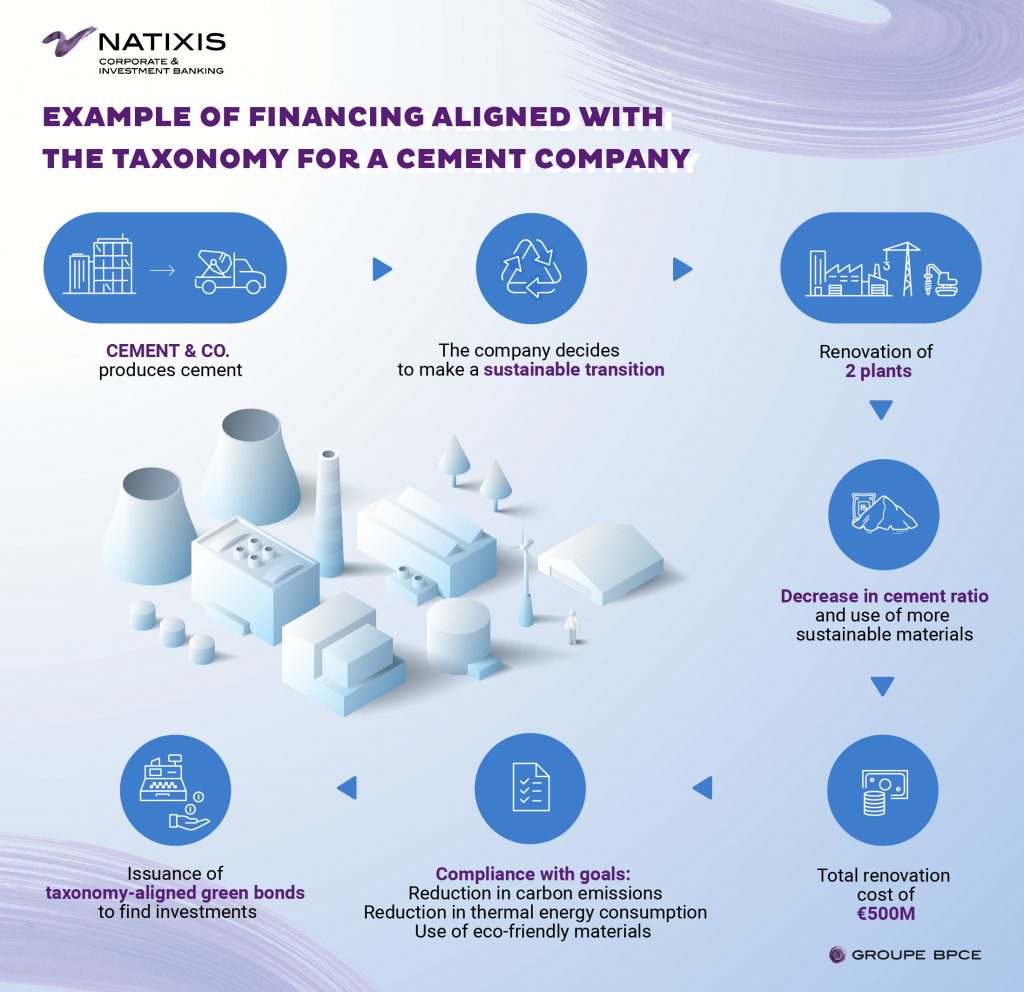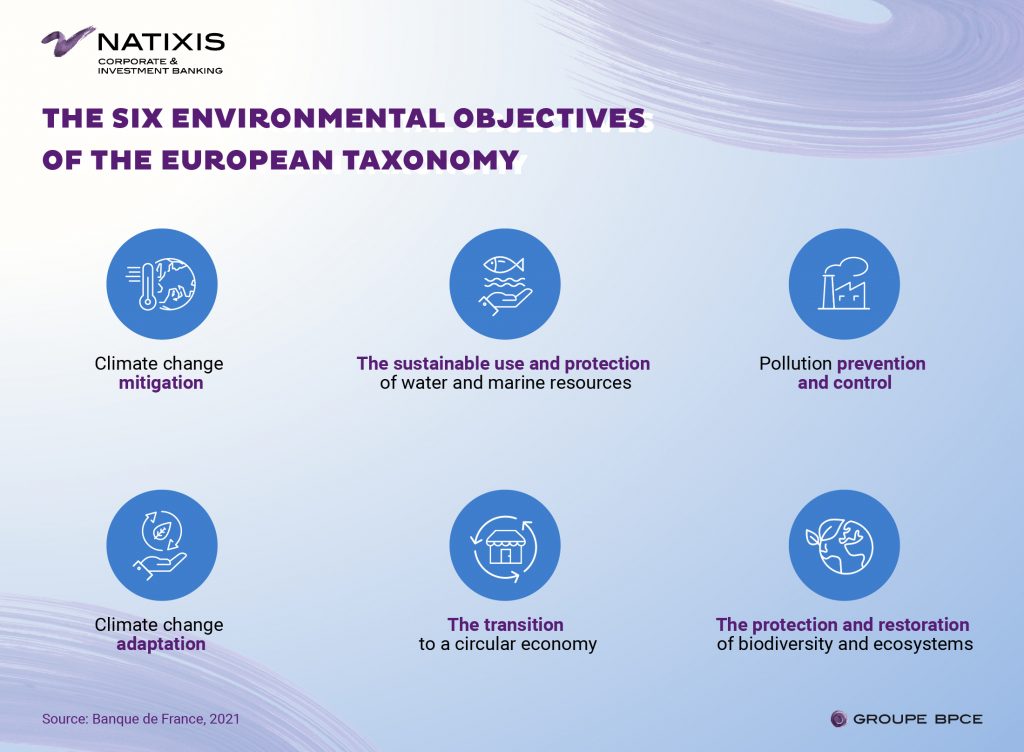
Explaining the EU taxonomy (episode 1)
Friday, 25 february 2022
Groupe BPCE has chosen to make climate change one of the major thrusts of its 2024 strategic plan. This issue is a huge, and extremely complex, challenge. In two episodes, our experts offer our stakeholders their insight into the European Commission’s green taxonomy project. Explanation.
Although there has been scientific consensus on the human origin of climate change for decades, agents in society and the economy have only more recently recognized the need to reduce global emissions in order to attain “carbon neutrality”3. According to the latest IPCC report4, unless there is an immediate, rapid and large-scale reduction in greenhouse gas emissions, it will be impossible to limit global warming to 1.5°C.
Multiple initiatives are now geared to attaining carbon neutrality, notably in the financial industry. Faced with this challenge, all economic agents – particularly businesses and governments – have a role to play. According to the OECD, €6.35 trillion of annual investment in carbon-reduction initiatives is needed to comply with the climate goals of the Paris Agreement between now and 2030. However, public sector commitments are insufficient to meet this challenge and the contribution of financial institutions and private capital is indispensable.
Although a low-carbon economy is slowly emerging, it is vital to define a body of rules, tools and incentives at European level in order to accelerate environmental transition. Hence the need to create a common language via a European green taxonomy which encourages investors to support the European Union’s environmental drive. As things stand, the full details of this “green taxonomy”, particularly as regards its deployment and appropriation, have yet to be completely finalized and fundamental work on many aspects is still in progress. It also remains to be seen whether the incentives and mechanisms stemming from the green taxonomy are sufficiently demanding to respond to climate and environmental issues.
The need for a green taxonomy within the European Union
The term “taxonomy”, originally used in the field of life sciences, comes from the Greek words nómos (law, rule) and ónoma (name) and means “classification methods”. The green taxonomy project launched by the European Commission in 2018 aims to establish a common classification methodology. It notably involves defining the carbon emission limits and all the other specific criteria that need to be respected for a company’s activities or a financial product (investment portfolio or fund) to be considered “sustainable”. This taxonomy covers over 90 sectors of economic activity that together accounted for 93% of greenhouse gas emissions in the European Union in 2021 and therefore embraces virtually all emitting sectors that need to be engaged in the fight against climate change.
In the private sector, the green taxonomy has the value of a label: financial players that invest in high carbon-emitting activities are not directly penalized for it and the companies concerned “only” report the proportion of their activities aligned with the taxonomy criteria. Nevertheless, this transparency is expected to guide market players in their decisions and facilitate fully-informed arbitrage by investors.
The objective behind the classification and the information disclosed is to trace or account for the financial flows invested in economic activities that contribute positively to environmental challenges such as fighting climate change or protecting biodiversity. Ultimately, the taxonomy enables market players to identify and favor investments that are beneficial to the planet to the detriment of those that are harmful to it, according to their own will and the constraints imposed by their stakeholders.

The advantages of a tool serving environmental transition
By distinguishing between what is green and what is not, the taxonomy acts as a tool that fosters transparency, comparisons and standardization for economic agents. In time, it could be used to fight certain abuses like greenwashing, by simplifying comparisons of products and their greenness. The European taxonomy’s classification system covers six environmental objectives:

An activity is deemed to be sustainable if it contributes substantially to one of these six environmental objectives, without causing sizeable harm to any of the five others.
The limits of the green taxonomy: multiple disagreements and debates
The European Parliament adopted a rule defining the green taxonomy which will gradually enter into force until the end of 2023. This European “environmental grammar” must enable investors to establish whether their investments contribute to the goals set out in the European Green Deal – namely carbon neutrality by 2050 ─ which is a precondition for respecting the 2015 Paris Agreement. If financial organizations are going to have access to this information, companies are going to have to officially publish the degree to which their activities are eligible for the taxonomy by the end of 2022. As things stand, the information disclosed by companies varies greatly, thus emphasizing the need to put standardized structures in place.
For EU member states, the definition of the green taxonomy harbors a financial issue and especially a major economic and regulatory impact. This is especially the case if European aid measures (system of state aid, recognition of public deficits) become destined to cover solely, or be of more benefit to, economic and energy activities that are consistent with the taxonomy’s framework. On February 2, 2022, the European Commission published a draft legal text concerning the inclusion of nuclear and gas activities into the taxonomy, under conditions that are more or less strict and applicable. By proposing to align certain nuclear and gas plants with the taxonomy, this project has aroused opposition in certain quarters, with some European states like Luxembourg and Austria resolutely against it. These states hope to prevent the text from being adopted by filing a lawsuit with the European Court of Justice. Other countries in favor of including these activities in the taxonomy are heavily reliant on nuclear energy (like France) or gas (like Germany), to meet their short- and medium-term goals for reducing greenhouse gas emissions.
A complex European project currently being defined
The green taxonomy project is not yet complete and by nature will be subject to regular updates and adjustments: some sectors are not covered as yet (the mining industry, for example) and the technical criteria linked to four of the six environmental objectives have still not been defined. Over the medium and long terms, other classifications are planned, particularly a “brown taxonomy”. Unlike the green taxonomy, this brown taxonomy is likely to highlight activities the most harmful to environmental goals, particularly climate change, and thus avert the risk entailed by excessive exposure to these sectors. It is liable to help redirect capital flows away from these sectors considered to be harmful or incompatible with climate goals and toward those deemed to be neutral or sustainable.
The Platform on Sustainable Finance Platform, a consultative group of experts tasked with helping the European Commission to implement the European Sustainable Finance Action Plan, suggests making the taxonomy more granular. It is examining the possibility of a taxonomy organized into several levels (green, brown and neutral) thereby allowing for greater nuance and finesse in the analysis of environmental performance (sustainable, intermediate or harmful).
In parallel, the possibility of a social taxonomy is also being examined. Initial work took place in 2021 and it is planned to decide in 2022 whether there is a need in the short term to take this idea forward and bring it to fruition. The objective would be to redirect capital flows to companies and activities that respect human rights and demonstrate good corporate governance. It would also be a means of supporting investments that improve living conditions by ensuring essential needs are satisfied (housing, transport, health, etc.), particularly for disadvantaged populations.
The taxonomies project remains incomplete and is also global, with numerous initiatives in different jurisdictions (China, UK, Canada, Russia, South Africa, Chile, Mexico, etc.) and many aspects still to be specified. By nature, it is destined to evolve and be adapted on a regular basis.
Click here to read episode 2: Explaining the European taxonomy
Sources:
Summary for Policy Makers of the Intergovernmental Panel on Climate Change (IPCC) Special Report on Global Warming of 1.5ºC
OECD. 2017, Investing in Climate, Investing in Growth, OECD Publishing, Paris.
Taxonomy verte : comment l’Union européenne promeut les activités en faveur du climat, Toute l’europe.eu, November 2021.
La Commission européenne dévoile un projet classant les investissements dans le nucléaire comme « durables », Le Monde, January 2022.
La Taxonomy européenne : pièce centrale de la stratégie réglementaire européenne pour une finance durable, Carbone4.com, July 2021.
La taxonomy européenne des investissements verts : ambitions, tractations, capture, Alternatives économiques, April 2021.
La taxonomy, un dictionnaire européen pour définir les activités « vertes », Les Echos, January 2022.
Brussels proposes green label for nuclear and natural gas, The Financial Times, January 2022.